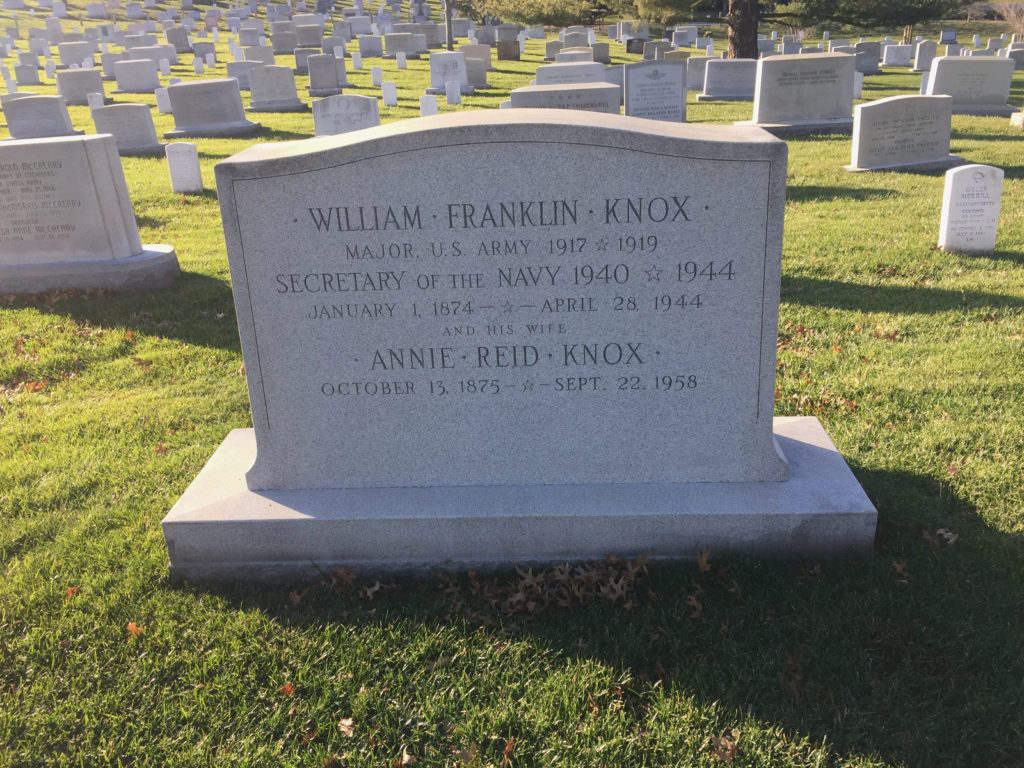Erik Visits an American Grave, Part 821
This is the grave of Frank Knox.

William Franklin Knox was born in Boston in 1874. His family were Canadian immigrants, but I guess we won’t hold that against him. The family was middle class; his father ended up owning a grocery store in Grand Rapids, where the family moved in 1883. He dropped out of school at age 15 and worked a number of jobs. When the Panic of 1893 made work hard to find, Knox enrolled at Alma College, but dropped out in his senior year in the excitement to join the Spanish-American War. The college allowed him to finish his studies from the Army, and he graduated in 1898. Meanwhile, he was actually in Theodore Roosevelt’s Rough Riders, one of the non-elite, non-cowboy contingent that filled out that weird and massively overrated regiment.
After his fun in Cuba, Knox returned to Grand Rapids and worked as a newspaper reporter. By 1900, he was calling himself Frank instead of William. He was a staunch Republican, though one with Progressive tendencies. He had gotten involved in supporting Republican candidates in Michigan by about 1900. In 1912, by now living in New Hampshire, he was a big supporter of Roosevelt’s Bull Moose ticket, though whether this was out of personal loyalty to his old commander or ideological reasons, I’m not really sure but the former was definitely a big consideration. Although now not that young, Knox immediately volunteered to fight in World War I. He had advocated for joining the war before 1917 anyway. As a well-connected guy with a little bit of military experience, making him a lot more experienced than most people, he was an artillery officer who saw action in France and was promoted to major.
When he was mustered out at the end of the war, Knox went back to his newspapers and his Republican politics. He was the floor manager for Leonard Wood’s presidential campaign at the 1920 Republican National Convention, though the hapless Warren Harding won that battle. William Randolph Hearst hired him later in the 20s to help run his empire. He was publisher of the Chicago Daily News beginning in 1930 and rose enough in Republican politics to be named Alf Landon’s VP candidate in 1936. To say the least, he did not help the ticket in that epic landslide. In fact, Knox himself had wanted the presidential nomination. Knox’s contribution to the ticket was his many editorials that the New Deal was destroying everything good about the nation. This….did not resonate with the American population, but it sure did with the Republican elite who hated Roosevelt.
Knox again was aggressive in his support for the U.S. joining World War II, urging preparedness from his newspapers. Even though he hated Roosevelt’s politics, they saw eye-to-eye on the war and so when Roosevelt asked Knox to become Secretary of the Navy in 1940, he agreed, arguing to his supporters that it was good to have non-New Dealers in the government. From Roosevelt’s perspective, inviting Knox and Henry Stimson into the government was a good move to build bipartisan support for what he rightfully saw as the inevitability of the nation jointing the war. When he was named Secretary of War, a Life article stated that Knox “is a dusty museum piece that has come clanking into the present crisis straight out of the Theodore Roosevelt wing of the gallery of patriotism.” In fact, Knox was one of those old soldiers who loved to bore people with stories of the past and the heroism of TR. But to his credit, he did see Hitler as a threat to the world and took that TR attitude toward him, which of course is what appealed to FDR. Thus, he was a major supporter of Lend-Lease and worked hard on Republicans to see it through.
Knox was also a stone cold racist toward the Japanese. He didn’t just urge the locking up of Japanese-Americans in 1942; he had been advocating that position since 1933! He wanted the Japanese in Hawaii locked up too, which mercifully did not happen. What did Knox do as Secretary of War? One big thing was barring Japanese-Americans from joining the Navy. Even in 1944, he was promoting rounding up all the Japanese in Hawaii and throwing them on Molokai. That wasn’t all he did. Certainly he deserves credit for coordinating the extremely rapid growth of the Navy and all the production facilities to make that happen, though he was far from alone here. He also did a good job professionalizing the stale old institution by hiring leading young businessmen, lawyers, and efficiency experts to help build up the service. But overall, he was a pretty bad guy.
Knox died of a heart attack in 1944, while he was still Secretary of the Navy. He was 70 years old.
Frank Knox is buried on the confiscated lands of the traitor Lee, Arlington National Cemetery, Arlington, Virginia.
This grave visit was sponsored by LGM reader donations. Thanks!! If you would like this series to visit other Secretaries of War, you can donate to cover the required expenses here. Charles Edison is in Orange, New Jersey and Claude Swanson is in Richmond, Virginia. Previous posts in this series are archived here.


